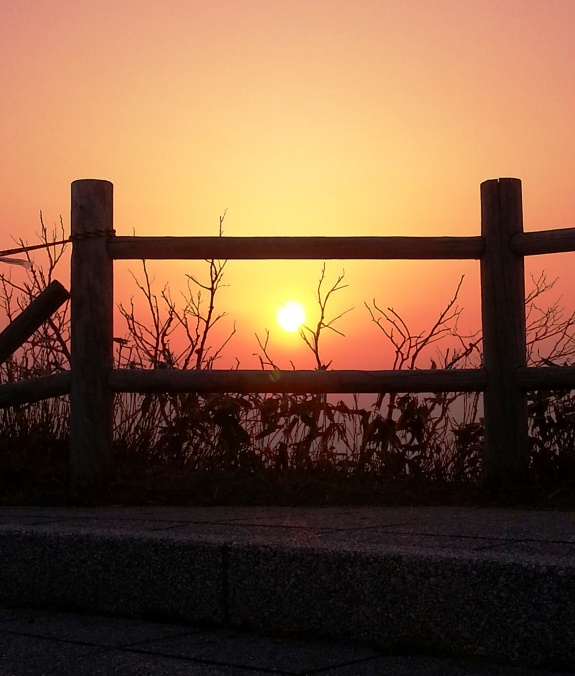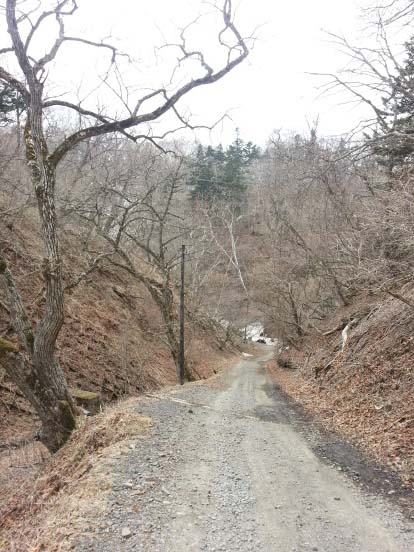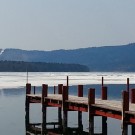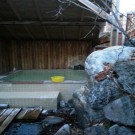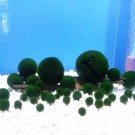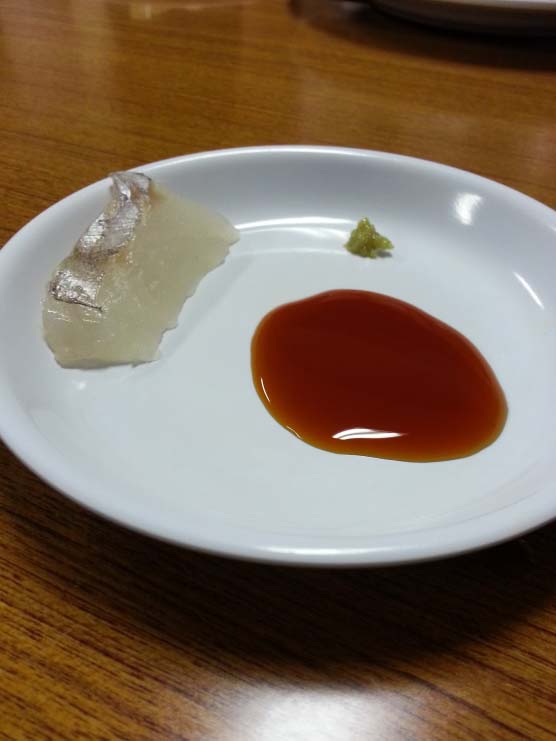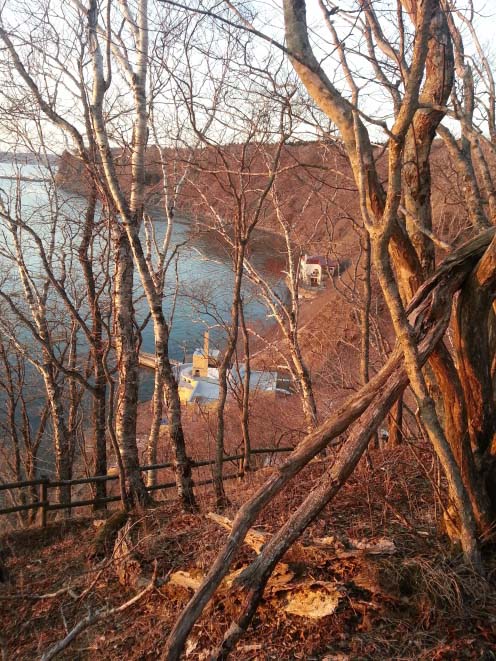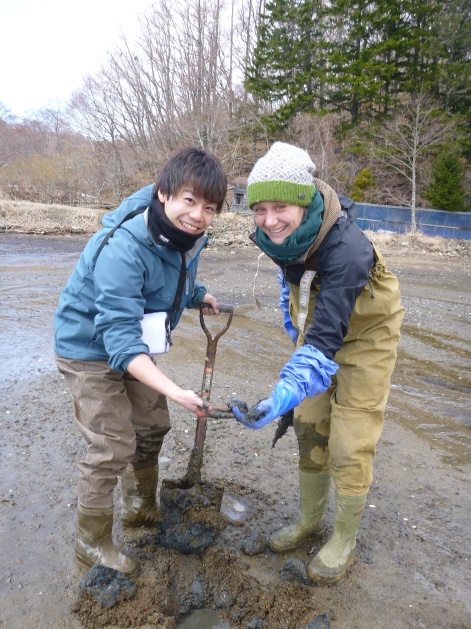Here is the report from Myriam Perschke, part of team Japan. An interesting insight into the land of the rising sun.
Here in Akkeshi, a town with about 10,000 inhabitants (mostly fishermen), which is located in the Hokkaido Prefecture in North-East Japan, the sun actually rises quite early in spring. At around 4 am, the first sun rays enter my room. Being located at 43.3° N, Akkeshi is almost on the same latitude as Florence in Italy. However, due to the lack of a warm water current, the climate in this corner of the world is on average about 10°C colder than in comparable places in Europe.
The steep road that leads downhill to the guest house and the laboratory of Akkeshi Marine Station. Photo: Myriam Perschke.
There was still snow around when I arrived at my new home, the Akkeshi Marine Station, which is located 7 km outside Akkeshi town, three weeks ago. Due to the frost, the ride down the steep (~27° inclination) gravel road that leads to the institute’s guest house was really jumpy. Without special snow equipment this trail is nearly impassable for cars during winter. The guest house is for 30 persons, but most of the time only my team partner Hiromi Sugai, Venus Leopardas, a researcher from the Philippines, and me are here. The view over Akkeshi Bay from the window of the dining room is amazing and lets us start into the day in a different way: In front of the guest house lays the stretch of sea that connects Akkeshi Bay to the Pacific Ocean. When the weather is sunny and calm, you can easily spot patches of seagrass and kelp (kombu) out there, while seagulls and cormorants rest on the oceans` surface. Deer from the surrounding forest are daily visitors and once in a while a fox passes by, an eagle circles at the sky or a seal peeps out of the sea. Furthermore, people here keep telling stories about a Japanese brown bear that came to visit the laboratory two years ago. What is even more exciting: Just recently one individual was seen some kilometres away. Amid the remoteness’ of my new location, I can say that Akkeshi is a fascinating place to stay, not only because the costs of living are lower here than in other places in Japan, but also because we are very close to nature.
- Lake in Akan National Park, still half frozen. Photo: Myriam Perschke
- A hot volcano spring (Onsen). Photo: Myriam Perschke
- Marimo algae. Photo: Myriam Perschke
The Japanese culture and language are really different from the German and in the beginning I felt lost in this country without knowing how to react and to behave and without being able to understand a single word. But thanks to the adorable people working in the laboratory and most of all to my team partner Hiromi, I already adapted a bit. Now I can go shopping for food in less than an hour or manage to eat with chopsticks without making a mess out of my meal. The food is more than delicious (if you like seafood) and Akkeshi is famous for oysters that are farmed here in huge amounts. I try everything, because I think the possibility to eat original Asian food prepared in this way will not come back. Yesterday, for example, one of the lab members caught a big rock fish while fishing in the night and he brought it directly to the dormitory. The fish was sliced into very thin pieces and around midnight we had self-made fresh Sashimi with soy sauce and wasabi. Delicious! I already found my favourite Japanese dish: Ramen. This is a kind of noodle soup with vegetables, fish or meat and the way of preparation differs from town to town. However, not everything you can find is suitable for our European palates and stomachs. There are, for instance, fermented soya beans (natto) that I am not able to swallow or raw clams that are really not my favourite food.
We already had some amazing weekend trips to the wildlife hotspots close by. The famous Japanese cranes can only be found here and we, of course, found them. There are volcanos and lakes with crystal clear water in which algae grow that have a perfect roundish ball-like shape (marimo algae). And here is my favourite: Due to the volcanic activity there are hot springs everywhere with a huge amount of sulphur and other minerals that are supposed to heal the skin and the body. Of course, we try to take a bath in every single one. I am really glad to experience all this. Maybe this is not the Japan we usually have in mind – with crowded places like Tokyo – but it is a side of the country that is beautiful and really impressing.
View from the mountain: The laboratory (in the front) and the dormitory (in the background) of Akkeshi Marine Station. Photo: Myriam Perschke
When looking at the rocky beach in front of our dormitory you can recognize differently coloured spots between the black boulders. It is plastic: Bottles, bags, cans, wires, wheels, pieces of boxes, buoys, styrofoam containers and, and, and. So, even our place in the middle of nowhere, far away from big cities, is already highly polluted with plastic debris – and the particles we see are only the big ones. What about the ones too small to see? If the big plastic is here, the small should be as well and that shows the urgency of our study.
During the last three weeks since our arrival, we (my team partner Hiromi Sugai and I) were preparing our experiments. The main aim of our project is to find out if filter and deposit feeding marine organisms -like mussels or lugworms- suffer from the plastic particles they take in from the surrounding water column or sediment. Plastic fragments which are smaller than 5 mm are not necessarily dangerous only because they can be ingested. However, they may become detrimental when they accumulated toxic pollutants on their surface. The intake of toxins with the plastic may harm benthic organisms and this could influence the basic levels of the food web in coastal habitats.Hiromi and me searching for our test organism: the lugworm Abarenicola pacifica. Photo: Myriam Perschke
Before starting, we needed to read a lot of literature, do pilot studies and buy material to be well prepared for the main experiment. We already did some first tests with our deposit feeding organism Abarenicola pacifica, a lugworm, to get an idea about its feeding rate. This information will help us to estimate the amount of sediment the worms will process per unit time. This, in turn, is needed to adjust the frequency of plastic renewal during the experiment. Furthermore, we sieved kilos of sediment to provide them food and a natural habitat in the aquaria. The sieving is necessary, because dead or living organic material like other worms or snails that are in the sediment could have an impact on the water quality.
We also spent a lot of time solving problems that could not be foreseen during our preparation course in Kiel. For the experiments, for example, we need around 120 individuals of each of the test species. First of all, we had to check if we can keep so many animals in the Akkeshi laboratory for 3 months. The space inside the basins of this well-equipped laboratory is limited. But thanks to the technicians of the laboratory, we already solved this problem: They will construct special shelves for us. Another issue was to find an appropriate filter feeding organism. Our first choice was the mussel Mytilus trossulus, but so far we were not able to find enough of them in the field. We already asked other lab members, local fishermen, researchers and the oyster farmers here in Akkeshi where we can find more mussels. The fishermen, however, explained us that M. trossulus will appear later in spring – more or less 1 month from now. Furthermore, due to the high abundances of barnacles here, which compete with the mussels for rocky substrates, their numbers are generally low.
Some years ago, Pamela Brannock, who is now working at Auburn University in USA, investigated the distribution of Mytilus species in Japan genetically. She gave us the hint that there are hybrids here between Mytilus trossulus and Mytilus edulis. We therefore thought about changing the study organism to avoid difficulties with the proper identification of the animals. However, since other test organisms, such as scallops and oysters, are more difficult to handle, we will accept this uncertainty for our experiments.
Finally, we also found more mussels. A representative of the Oyster Seed Center in Akkeshi told us that Mytilus lives attached to mooring ropes in oyster farms. With the help of the oyster farmers we hopefully will be able to collect enough of them.
And then there is our biggest problem : Every day we are waiting for the post man to bring these two big bags filled with 15 kg of plastic powder each that we ordered in Germany. This is the most exciting question at the moment: Where is our plastic that we need for the experiments and which was sent to Japan over three weeks ago? We do not know – hopefully not on a sailing ship somewhere on its way over the Pacific Ocean. Time is running. Nonetheless, we will keep on waiting and not lose our hope. Not yet…
Greetings from Akkeshi Marine Station where the sun does not only rise so early but also shows its best side while setting…
We are looking forward to hearing more from the other teams, soon.
Regards,
Mark
